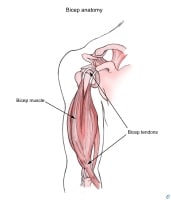Tendon ruptures of the biceps
brachii, one of the dominant muscles of the arm, have been reported in
the United States with increasing frequency. Ruptures of the proximal
biceps tendon make up 90-97% of all biceps ruptures and almost
exclusively involve the long head.
 Biceps muscle and tendons The
biceps muscle then continues down the arm within the intertubercular
groove, covered by a synovial outpouching of the joint capsule. The 2
muscle bellies unite near the midshaft of the humerus and attach
distally on the radial tuberosity. The distal tendon blends with the
bicipital aponeurosis, which affords protection to structures of the
cubital fossa, allowing distribution of forces across the elbow to
lessen the pull on the radial tuberosity.[1, 2] The biceps receives innervation via the musculocutaneous nerve (C5, C6) from the lateral cord of the brachial plexus.
Biceps muscle and tendons The
biceps muscle then continues down the arm within the intertubercular
groove, covered by a synovial outpouching of the joint capsule. The 2
muscle bellies unite near the midshaft of the humerus and attach
distally on the radial tuberosity. The distal tendon blends with the
bicipital aponeurosis, which affords protection to structures of the
cubital fossa, allowing distribution of forces across the elbow to
lessen the pull on the radial tuberosity.[1, 2] The biceps receives innervation via the musculocutaneous nerve (C5, C6) from the lateral cord of the brachial plexus.
Anatomy
Because of its size and its orientation about the shoulder and elbow joints, the biceps muscle is involved in functional activities of the upper limb. At its proximal attachment, the biceps has 2 distinct tendinous insertions on the scapula from its long and short heads. The short head arises from the coracoid process with the coracobrachialis, while the long head originates from the supraglenoid tubercle and passes over the humeral head within the capsule of the glenohumeral joint (see image below). Biceps muscle and tendons The
biceps muscle then continues down the arm within the intertubercular
groove, covered by a synovial outpouching of the joint capsule. The 2
muscle bellies unite near the midshaft of the humerus and attach
distally on the radial tuberosity. The distal tendon blends with the
bicipital aponeurosis, which affords protection to structures of the
cubital fossa, allowing distribution of forces across the elbow to
lessen the pull on the radial tuberosity.[1, 2] The biceps receives innervation via the musculocutaneous nerve (C5, C6) from the lateral cord of the brachial plexus.
Biceps muscle and tendons The
biceps muscle then continues down the arm within the intertubercular
groove, covered by a synovial outpouching of the joint capsule. The 2
muscle bellies unite near the midshaft of the humerus and attach
distally on the radial tuberosity. The distal tendon blends with the
bicipital aponeurosis, which affords protection to structures of the
cubital fossa, allowing distribution of forces across the elbow to
lessen the pull on the radial tuberosity.[1, 2] The biceps receives innervation via the musculocutaneous nerve (C5, C6) from the lateral cord of the brachial plexus.
No comments :
Post a Comment